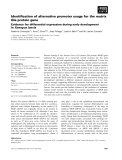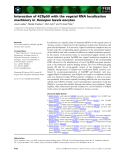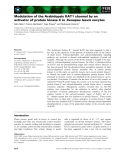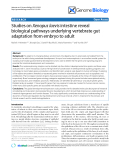
Xenopus laevis
-
Thyrotropin-releasing hormone receptor (TRHR) has already been cloned in mammals where thyrotropin-releas-inghormone (TRH) isknowntoactasapowerful stimulator of thyroid-stimulating hormone (TSH) secretion. The TRH receptor of amphibians has not yet been characterized, although TRH is specifically important in the adaptation of skin color to environmental changes via the secretion of a-melanocyte-stimulating hormone (a-MSH).
 11p
11p  research12
research12
 23-04-2013
23-04-2013
 33
33
 4
4
 Download
Download
-
To analyze the regulation of Matrix Gla Protein (MGP) gene expression inXenopus laevis, we cloned the xMGPgene and its 5¢ region, determined their molecular organization, and characterized the transcriptional properties of the core promoter. TheXenopusMGP (xMGP) gene is organized into ®ve exons, one more as its mammalian counterparts.
 10p
10p  research12
research12
 23-04-2013
23-04-2013
 57
57
 3
3
 Download
Download
-
Protein phosphatase 2A is a phosphoserine/threonine phosphatase implicated inmany cellular processes. The core enzyme comprises a catalytic and a PR65/A-subunit. The substrate specificity and subcellular localization are deter-mined by a third regulatory B-subunit (PR55/B, PR61/B¢ and PR72/130/B¢¢). To identify the proteins of the B¢¢family inXenopus laevisoocytes, aprophaseXenopusoocyte cDNA librarywas screened using humanPR130 cDNAas a probe. Three different classes of cDNAs were isolated....
 12p
12p  tumor12
tumor12
 20-04-2013
20-04-2013
 30
30
 3
3
 Download
Download
-
Recent cloning of theXenopus laevis(Xl) matrix Gla protein (MGP) gene indicated the presence of a conserved overall structure for this gene between mammals and amphibians but identified an additional 5¢-exon, not detected in mammals, flanked by a functional, calcium-sensitive promoter, 3042 bp distant from the ATG initiation codon.
 0p
0p  awards
awards
 06-04-2013
06-04-2013
 42
42
 3
3
 Download
Download
-
The Alzheimer’s disease-linked amyloid-bprecursor pro-tein (APP) belongs to a superfamily of proteins, which also comprises the amyloid-b precursor-like proteins, APLP1 and APLP2. Whereas APP has been identified in both lower and higher vertebrates, thus far, APLP1 and 2 have been characterized only in human and rodents. Here we identify the first nonmammalian APLP2 protein in the South African claw-toed frogXenopus laevis.
 7p
7p  dell39
dell39
 03-04-2013
03-04-2013
 46
46
 4
4
 Download
Download
-
Photolyase is a light-dependent enzyme that repairs pyrimidine dimers in DNA. Two types of photolyases have been found in frogXenopus laevis, one for repairing cyclobutane pyrimidine dimers (CPD photolyase) and the other for pyrimidine–pyrimidone (6–4)photoproduct [(6–4)photolyase]. However, little is known about the former type of theXenopusphotolyases.
 11p
11p  dell39
dell39
 27-03-2013
27-03-2013
 49
49
 3
3
 Download
Download
-
Localization of a specific subset of maternal mRNAs to the vegetal cortex of Xenopusoocytes is important for the regulation of germ layer formation and germ cell development. It is driven by vegetal localization complexes that are formed with the corresponding signal sequences in the untranslated regions of the mRNAs and with a number of different so-called localization proteins.
 10p
10p  viettel02
viettel02
 19-02-2013
19-02-2013
 37
37
 3
3
 Download
Download
-
TheArabidopsis thalianaK + channel KAT1 has been suggested to play a key role in the regulation of the aperture of stomatal pores on the surface of plant leaves. Calcium-dependent and calcium-independent signaling pathways are involved in abscisic acid-mediated regulation of guard cell turgidity. Although the activity of the KAT1 channel is thought to be regu-lated by calcium-dependent protein kinases, the effect of phosphorylation on KAT1 and the phosphorylated target sites remain elusive.
 11p
11p  mobifone23
mobifone23
 21-01-2013
21-01-2013
 41
41
 3
3
 Download
Download
-
Tuyển tập các báo cáo nghiên cứu về y học được đăng trên tạp chí y học Wertheim cung cấp cho các bạn kiến thức về ngành y đề tài: tudies on Xenopus laevis intestine reveal biological pathways underlying vertebrate gut adaptation from embryo to adult...
 0p
0p  thulanh22
thulanh22
 20-11-2011
20-11-2011
 44
44
 4
4
 Download
Download
-
The caveolin gene family has three members in vertebrates: caveolin-1, caveolin-2, and caveolin-3. So far, most caveolin-related research has been conducted in mammals, but the proteins have also been found in other animals, including Xenopus laevis, Fugu rubripes, and Caenorhabditis elegans. Caveolins can serve as protein markers of caveolae (‘little caves’), invaginations in the plasma membrane 50-100 nanometers in
 0p
0p  thulanh21
thulanh21
 15-11-2011
15-11-2011
 56
56
 3
3
 Download
Download
CHỦ ĐỀ BẠN MUỐN TÌM






















